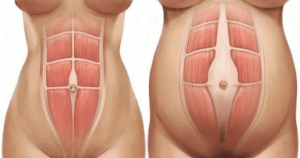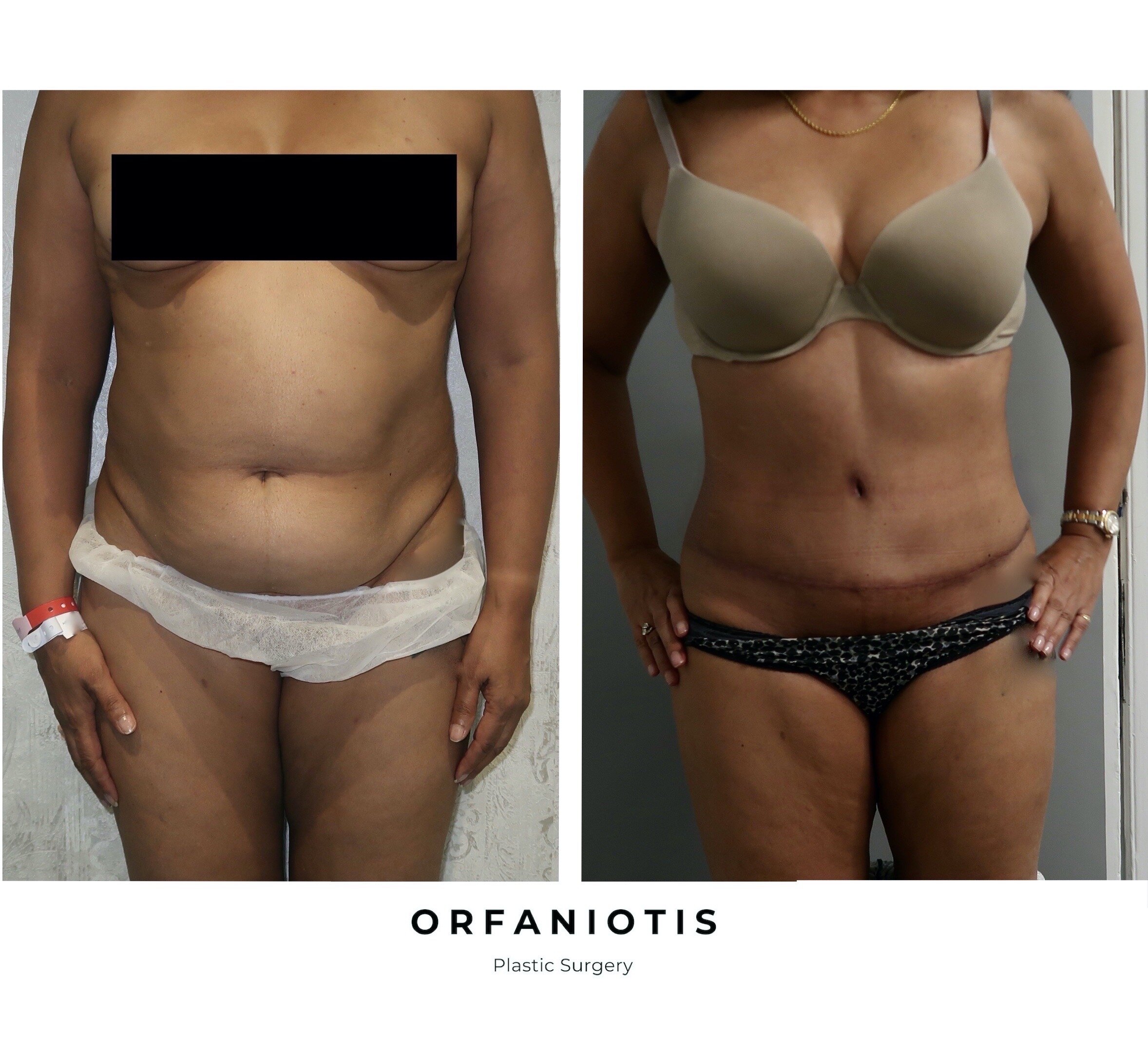Abdominoplasty: Mini vs Full, muscle tightening and Liposculpture - A guide to your Tummy Tuck
Abdominoplasty or ‘Tummy Tuck’ is a procedure that removes excess tissue and fat from the abdomen.
In this article we outline the most common questions about abdominoplasty Mr. Orfaniotis Consultant Plastic Surgeon hears in his London clinic. For more information or to book an appointment get in touch.
Who is a suitable candidate for this procedure?
Abdominoplasty may be a suitable procedure for those who have an excess of tissue or fat in the abdominal region.
This may be for a number of reasons.
· Most commonly this procedure is indicated in women following childbirth where there is often an excess of skin that is not treatable with diet and exercise alone.
. Pregnancy can also contribute to a variable degree of abdominal muscle separation (divarication recti), a condition that can also be treated during an abdominoplasty procedure.
· Another common indication is in those patients who have lost a lot of weight as this may have also led to an excess of skin.
· Lastly, general aging can lead to laxity in the abdominal skin, which again would not be amenable to diet and exercise.
The amount of excess fat and tissue, along with the degree of muscle separation present will determine the type of abdominoplasty you need.
Which type of abdominoplasty do I need?
In those patients with excess skin and only a moderate amount of fat below the belly button, they may be candidates for a ‘mini-abdominoplasty’ procedure. A mini tummy tuck can be an excellent option for patients with a relatively flat upper abdomen and some skin laxity below the belly button.
If there is a substantial amount of excess fat and tissue then the standard full abdominoplasty would be needed. And for some women additional liposuction to the flanks and upper abdomen may be an option to improve contour and definition and enhance the outcome.
Pic2 : Mini vs Full Abdominoplasty
The main difference between a mini- and a full abdominoplasty is that in the mini version the surgeon does not dissect the tissue over the upper abdominal area, above the belly button, and the belly button itself remains to its original position with no additional scars. This can result in a quicker recovery and a narrower scar.
However if tightening of the muscles in the upper abdomen is required, a mini-abdominoplasty would not allow for this and a full-abdominoplasty approach is necessary.
Do I need Muscle tightening?
Muscle tightening is most commonly needed in those patients who are presenting post pregnancy. The rectus abdominus muscles of the abdomen, or most commonly known as the ‘six-pack’ muscles have an important role not only in the aesthetics of the abdomen but also in core function. During pregnancy these muscles, which are usually tightly joined in the midline by a strong tissue layer called “fascia”, can separate as the pregnancy progresses. In some women following pregnancy they may return to a normal position, however in others they can remain separated and the fascia becomes weakened.
This separation is called ‘rectus divarication’ and can lead to reduced core function as well as an upper abdominal bulge due the weakness allowing the intra-abdominal contents to protrude forwards. The separation can be limited to lower or upper abdomen, or can extend the whole length of the abdomen.
Pic 2: Normal abdominal muscles of the left, and illustration of divarication on the right.
The other cause for divarication can be that of general aging when the tight fascia keeping the muscles together loses it’s connective tissue strength as part of the natural process of aging alongside loss of muscle mass. In this scenario tightening the muscles as part of the abdominoplasty procedure may also be beneficial.
During your consultation Mr. Orfaniotis will assess your muscle function and be able to advise you on the need for any muscle tightening during the procedure.
What does the Operation involve?
Mr Orfaniotis performs his abdominoplasty procedures under general anesthetic as a day case procedure. This means you would go home the same day. An overnight stay in the hospital may be advisable If additional procedures are being performed at the same time eg breast lift/arm lift, or for patients needing overnight monitoring.
A tummy tuck is often combined with liposuction in a procedure also known as Lipo-abdominoplasty. Liposuction can address excess tissue in the flanks, upper abdomen and below the waistband (mons pubis). For selected patients it is a great tool that enhances the outcome by improving the contour of the surrounding tissues and the definition of the abdominal wall (etching).
Mr Orfaniotis uses a “drainless” tummy tuck technique, whereby the skin and fat are brought close together to the abdominal wall with several layers of deep sutures (quilting). These quilting sutures significantly reduce the space for potential fluid collection, avoiding the need for surgical drains. The drainless technique is causing less pain, facilitates early mobilisation and an overall quicker recovery.
The procedure itself can take up to 3 hours depending on how much work there is to be done. After the procedure and you are awake you will monitored for a few hours to ensure you are feeling well enough to go home. You will be required to have a friend of family member collect you from the hospital and stay with you for the first 24 hours.
Prior to the procedure Mr Orfaniotis will mark out the area of tissue to be removed along with any areas that require liposuction.
How long is the recovery?
In the first 48 hours you can feel a bit uncomfortable and tired as you recovery from the general anesthetic and get used to your new abdomen. You may expect to take some simple over the counter pain medication such as paracetamol in this first week.
For those women who had muscle tightening, there can be some twinges and tenderness of the muscles for 2 weeks, specifically when getting up from a lying position as the muscles activate.
In order to support your core muscles during the recovery Mr. Orfaniotis will advise to wear a pressure garment. This acts not only as a support but also to help prevent any collection of fluid in the abdomen – a seroma. The garment is to be worn continuously for 6 weeks. If your procedure was combined with Liposuction, Mr Orfaniotis will encourage you to have lymphatic drainage treatment. This will help with the swelling and shape and can start as early as 1 week after surgery.
During this first 6 weeks Mr. Orfaniotis advises against high intensity exercise or heavy weight lifting. Gentle walking and yoga are acceptable.
Drainless Lipo-Abdominoplasty
Mr Orfaniotis’ result at 10 weeks. Additional repair of diastasis recti with abdominal etching and Liposculpture to flanks and bra-roll.
What are the risks of the operation?
Abdominoplasty surgery is considered very safe, however there are some early and late complications that you should know before proceeding.
Early complications following abdominoplasty are very rare and include bleeding, infection and delayed wound healing
If bleeding occurs after surgery this will very soon lead to the formation of a hard swelling due to a clot (hematoma) under the abdominal skin. It will require a return to the operating theatre to wash out the clot and stop the bleeding.
Wound infection is again a rare event, however should it happen, it usually settles with a course of antibiotics.
Wound healing issues may also occur, more commonly at the tightness part of the abdomen, which is in the central area of the scar. Minor wound breakdown usually settles with dressings and does not compromise the overall outcome. Large wound breakdown is very rare and may require revisional surgery. It is important to limit high intensity exercise during the first 6 weeks to help prevent this complication.
Other Late problems after abdominoplasty surgery include:
Seroma. This is a collection of fluid under the abdominal skin. The fluid is naturally produced by the body throughout the day and normally drains into the small channels of the lymphatic system. After surgery the natural path of the fluid is disrupted and in the minority of people it can take several months for the channels to reform. Post-operative use of the binder as mentioned above helps prevent this alongside Mr Orfaniotis special stitching closure technique.
Fat necrosis. This is a condition where parts of fatty abdominal tissue loose the blood supply and become lumpy and tender. This is a higher risk in those who smoke. It is managed with massage techniques and can take a couple of months to resolve fully.
Scarring problems. Some people genetically form poor quality scars that can be red and lumpy (hypertrophic), or even grow out of proportion (keloid). Patients usually know already when they have scarring issues and there are a number of options available to prevent bad scarring, or to treat them when they occur.
What will my scars look like?
Mr Orfaniotis designs the operation so your final scar can be hidden under the bikini line. For those women undergoing a full abdominoplasty procedure, the scar would extend from one hipbone to the other. For those only needing a mini-abdominoplasty the scar would be 2/3rds of this length.
In a very small number of patients, Mr. Orfaniotis may need to perform a ‘Fleur-de-Lis’ Abdominoplasty that would results in an additional vertical scar from the newly positioned belly button to bikini line. This is specifically indicated for those patients with large horizontal skin excess above the umbilicus, most commonly found following massive weight loss.
Scars take up to a year to fully mature. For the first 3 months they will be red in colour as part of the healing process, but after this point they start to fade. Undertaking scar massage can help speed this process. Final scar results can depend on genetics and lifestyle factors such as ensuring a healthy diet with adequate vitamin C intake. Smoking can have a negative impact on the body’s ability to heal and increases risks of complications.
Before and After Photos
Drainless Lipo-Abdominoplasty with muscle tightening
Lipo-Abdominoplasty. Early result by Mr Orfaniotis at 3 weeks. Scar is fresh and will mature and fade after 12 months







